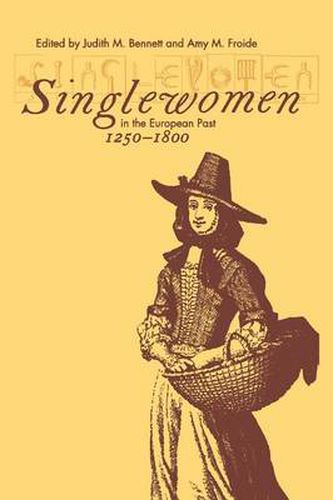Readings Newsletter
Become a Readings Member to make your shopping experience even easier.
Sign in or sign up for free!
You’re not far away from qualifying for FREE standard shipping within Australia
You’ve qualified for FREE standard shipping within Australia
The cart is loading…






When we think about the European past, we tend to imagine villages, towns, and cities populated by conventional families-married couples and their children. Although most people did marry and pass many of their adult years in the company of a spouse, this vision of a preindustrial Europe shaped by heterosexual marriage deceptively hides the well-established fact that, in some times and places, as many as twenty-five percent of women and men remained single throughout their lives.
Despite the significant number of never-married lay women in medieval and early modern Europe, the study of their role and position in that society has been largely neglected. Singlewomen in the European Past opens up this group for further investigation. It is not only the first book to highlight the important minority of women who never married but also the first to address the critical matter of differences among women from the perspective of marital status.
Essays by leading scholars-among them Maryanne Kowaleski, Margaret Hunt, Ruth Mazo Karras, Susan Mosher Stuard, Roberta Krueger, and Merry Wiesner-deal with topics including the sexual and emotional relationships of singlewomen, the economic issues and employment opportunities facing them, the differences between the lives of widows and singlewomen, the conflation of singlewomen and prostitutes, and the problem of female slavery. The chapters both illustrate the roles open to the singlewoman in the thirteenth through eighteenth centuries and raise new perspectives about the experiences of singlewomen in earlier times.
$9.00 standard shipping within Australia
FREE standard shipping within Australia for orders over $100.00
Express & International shipping calculated at checkout
When we think about the European past, we tend to imagine villages, towns, and cities populated by conventional families-married couples and their children. Although most people did marry and pass many of their adult years in the company of a spouse, this vision of a preindustrial Europe shaped by heterosexual marriage deceptively hides the well-established fact that, in some times and places, as many as twenty-five percent of women and men remained single throughout their lives.
Despite the significant number of never-married lay women in medieval and early modern Europe, the study of their role and position in that society has been largely neglected. Singlewomen in the European Past opens up this group for further investigation. It is not only the first book to highlight the important minority of women who never married but also the first to address the critical matter of differences among women from the perspective of marital status.
Essays by leading scholars-among them Maryanne Kowaleski, Margaret Hunt, Ruth Mazo Karras, Susan Mosher Stuard, Roberta Krueger, and Merry Wiesner-deal with topics including the sexual and emotional relationships of singlewomen, the economic issues and employment opportunities facing them, the differences between the lives of widows and singlewomen, the conflation of singlewomen and prostitutes, and the problem of female slavery. The chapters both illustrate the roles open to the singlewoman in the thirteenth through eighteenth centuries and raise new perspectives about the experiences of singlewomen in earlier times.